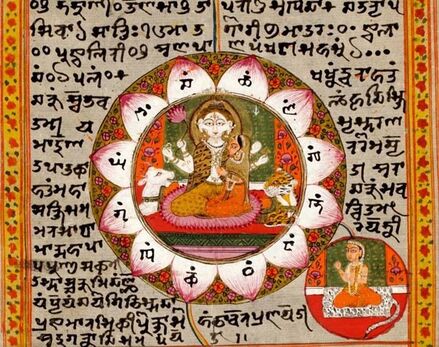 A SCROLL OF MEDITATIVE CHAKRAS RAJASTHAN, 18TH/19TH CENTURY Opaque watercolor, gold, and ink on paper. 103 x 8 1/2 in. (262 x 21.6 cm) A SCROLL OF MEDITATIVE CHAKRAS RAJASTHAN, 18TH/19TH CENTURY Opaque watercolor, gold, and ink on paper. 103 x 8 1/2 in. (262 x 21.6 cm) Today on Mothers day, I am revisiting and reflecting on my studies from a few years ago on the Universal mother. This teaching is a translation of an amazing tantric scroll, which dates to about 1000 years ago, translated by Sanskrit scholar Chris Tompkins in 2014. The scroll depicts a beautiful 12 chakra system, as well as teachings for embodying the Universal mother. I had the pleasure of seeing a variation of this scroll, and other similar artwork, when it toured Australia in 2009 as part of the Goddess- divine energy art exhibition. It was truly a remarkable piece of art and history that I am so pleased I got to see with my own eyes – it was just under 4 metre long and beautifully detailed. In my reflections today am reminded that mother is first and foremost an energy, not a person. All of us embody the qualities of mother at varies times as it is the universal energy of life. Many of us mentor, support, nurture and inspire each other, all qualities of mother energy. We also all contain desire for love and intimacy, also associated with mother energy. The Jagd Matr text poetically describes the chakras as a garland of lotuses strung on the central stem of the sushumna nadi (the central energy channel of the body). The soul is described like a bee, that resides in the top most chakra, and is encouraged through the practices described in the text to visit all the chakras, collect the nectar from each and then settle down in the chakra of the heart as the humsa (or unification of the in breath and the exhale breath in the heart space). The Universal Mother in this chakra scroll is understood to be the ground of being, the highest reality that contains the whole of the Universe in her very being. The scroll lists 50 “little mothers” which are the divinities of each petal of the 6 main chakras. The goddesses are represented by all the letters of the Sanskrit alphabet. The practices described in the text were previously lost (or not shared widely) and are based on mantra (sound vibration), pranayama (breathing practices) and meditation. Asana is understood to be the throne on which we sit to do the practices, and the practices were undertaken by householders who were likely to have been initiated, but not living away from their family and daily responsibilities. The recent translation of this scroll challenges some previously assumed knowledge of these practices, and gives us a different seed syllable sound for each chakra, as well as different deities than in other chakra writings from the last 100 years made popular by the Theosophical society. The text interestingly uses the term yoginam to refer to both male and female practitioners, in contrast to the later dated scrolls which only use the masculine term yogi, highlighting the feminist nature of the entire scroll, and the importance of the energy of mother to everyone. If you are curious about this chakra system and some of the practices it describes, I will be sharing some that I use from this at the Winter Solstice Kind-fulness retreat.
0 Comments
Leave a Reply. |


